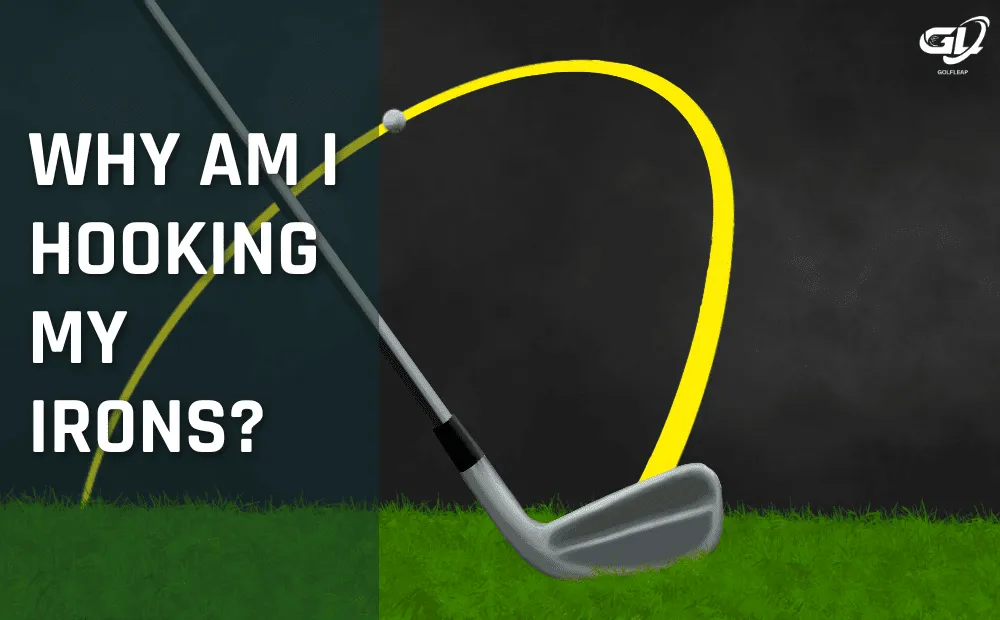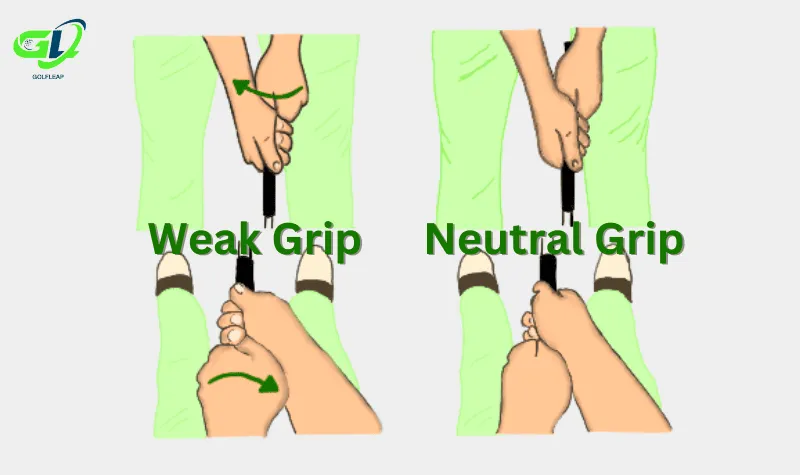
Why Am I Hooking My Irons Constantly?
Living legend and Hall-of-Fame golfer Lee Travino is famously quoted saying, “You can talk to a fade, but a hook won’t listen.”
Whether it’s a “snap hook” that puts you in immediate trouble right off the clubface or a big sliding hook that tumbles into danger once it finds the ground, hooks cost golfers a ton of strokes on the golf course.
Our breakdown below will discuss the 4 primary causes of hooked iron shots, how to fix these problems, and how to hit a hook on purpose when needed! If you’re more of a slicer, we got you covered on fixing your slice too.
Table of Contents
What is a Hook?
In the simplest terms, a “Hook” or “Hooked” golf shot moves dramatically right-to-left for right-handed golfers and left-to-right for left-handed players. Another great way to categorize a “Hook” is by calling it the “extreme version” of a “Draw.”
Hooks can be hit with nearly any club, but the most dangerous versions appear with tee shots and irons.
Regardless of the situation where you hit a hook, hooks usually cause big problems for players because the ball ends far away from the intended target with a lot of speed (often going into a hazard or completely out of bounds.)
What causes a hook with your irons?
Here are the four main problems with the general set-up of the golf swing that causes uncontrollable hooked shots.
- Improper Feet Alignment
- Improper Shoulder Alignment
- Too Strong of a Grip
- Incorrect Ball Position In Stance
I personally fought a consistent hook for the first 6 years of my golfing career, so I feel confident in my ability to turn your hook into the beautiful tight draw or straight shot of your dreams!
Improper Feet Alignment

A problem I notice with many of my friends that hook the ball (and a problem I have to be conscious of for myself) is aiming too far right of the target (for right-handed players, lefties reverse this.)
When you aim your feet towards or even to the right of your intended target, you set yourself up for either a hook or a “pushed” shot that starts right and continues going right of your intended landing spot.
Even worse, once you start planning for a hook, you’ll continue aiming further and further right of your target, only making the problem continually get worse!
Aiming right with your feet limits your ability to rotate and square your clubface at impact. Golfers like Viktor Hovland and Abraham Ancer intentionally aim right of their target but use their strong bodily rotation to allow this move to work to their advantage.
We amateur and recreational golfers should focus on aiming our feet parallel to our target line rather than aiming them at our target line, which should aid many players’ Hook issues.
Improper Shoulder Alignment
Just like our feet, our shoulders should aim parallel to our target line, not point directly at our target.
Our shoulders do much of the work in dictating where our swing path (how the club moves during the golf swing) guides our golf ball. When the shoulders point at the target or right of the target, we unintentionally cause a more severe “Inside-to-Out” swing path that puts right-to-left spin on the golf ball.
When our shoulders are in this “closed” position, we can’t help but drag the club inside toward our body on the backswing, forcing the club away from our body and out to the right on the follow-through.
By aiming our shoulders parallel to our target line, we encourage a more “on-plane” swing path, where the downswing and backswing are virtually mirrored images of the other.
Not only does fixing our shoulder angle cause straighter iron shots, but it also feels exponentially more comfortable.
Too Strong of a Grip

The golf grip has endless variations, but one thing is certain. A “strong grip” causes a closed club face and hooked golf shots.
No, a “strong grip” doesn’t mean you’re holding the club too tightly; it means your hands are rotated in too strong of a position to hit good golf shots that don’t hook.
When you grab an iron, the “V” created between your thumbs and index fingers should both point at your rear shoulder, like the “Neutral Grip” left side of the image above.
If you’ve decided to play golf after playing a different sport like baseball, it’s easy to fall into the trap of gripping the club too strongly because it feels more “natural” like other sports.
Gripping the club too strongly puts the club face in a position that points left of the target (right for left-handed golfers) with minimal loft. This means iron shots will immediately hook starting at impact with a low trajectory and eventually stop way left of the target.
Your grip is likely to blame if that sounds like your consistent ball flight.
Changing your golf grip is an uncomfortable process, but ultimately one of the most important things to fix to play great. A starting point is making sure those “V’s” created with your thumb and index finger point in the right direction, or you can check out our discussion and advice on Strong vs. Weak golf grips.
Incorrect Ball Position In Stance
Correct ball position is the most under-talked-about area of proper golf set-up but we’re here to tell you an incorrect ball position could be to blame for your hooked and sliced golf shots.
A great way to think about ball position is by remembering what Tiger Woods has always said:
Standing with three golf balls dividing the center of his stance, he said, “When I set up to a golf ball, if I’m going to hit a sand wedge, it’s going to be in the middle of my stance. When I hit a 5-iron it’s probably another ball (forward of center). When I hit driver, it’s probably another ball up.”
It’s easy to play the ball too far back in our stance (causing hooks) or too far forward (causing slices).
When the ball is too far back in our stance and closer to our rear foot, the club face doesn’t have time to square in relation to completing its swing path. When the ball is too far forward, the club face is already moving left of our body because of the natural path of the club, and it’ll often cause heel-bias contact and slices or faded shots.
Simplify your approach to ball positioning by using Tiger Wood’s tried and true method of the “1-2-3” golf ball trick, and you’ll be hitting straighter shots in no time!
How to Hit a Hook On Purpose
Unless you’re a very talented golfer, trying to play a hook as your typical shot isn’t a wise choice.
That being said, there are many situations we can find ourselves in on the golf course where having a hook shot on command can save us strokes!
Say you’re stuck behind a tree, and your only option is to hit a hook around the tree towards your target.
When we’re in this situation, we do three things:
- Close Our Stance
- Close Our Clubface
- Close Our Shoulders
1. Close Our Stance – By pointing our feet to the right of our target and trying to swing in the same direction our feet are pointing, we effectively create the “In-to-Out” swing path we described earlier that puts right-to-left spin on the golf ball.
2. Close Our Clubface – By pointing our club face left (as a right-handed golfer) of our target, we further encourage adding more right-to-left spin on the shot.
3. Close Our Shoulders – By aiming our shoulders to the right of our target, we essentially guarantee our swing path will be “In-to-Out,” and the ball will start out to the right and curve back left towards our intended target.
The Verdict: Why Am I Hooking My Irons?
It’s easy to get discouraged when you’re hitting hooks, but one thing that’s always kept me positive is remembering many of the best players in history (Rory, Tiger, Ben Hogan, etc.) have struggled with the same problem!
If you’ve found yourself hooking your iron shots, one of the four setup-based issues we’ve explained above is likely the cause.
The sooner you follow those tips, the sooner your scores drop!

